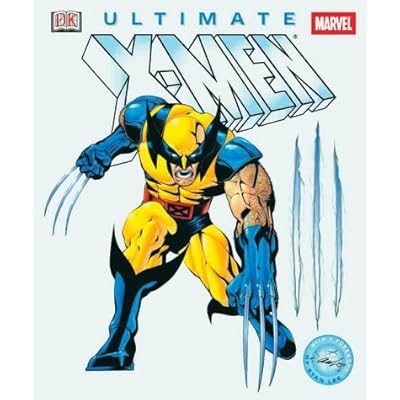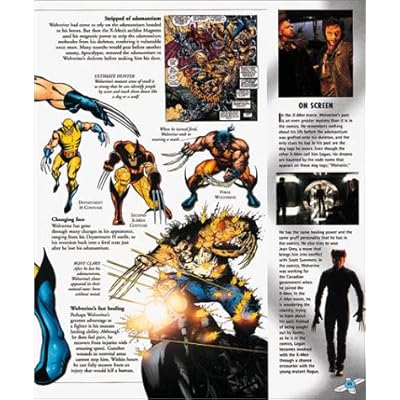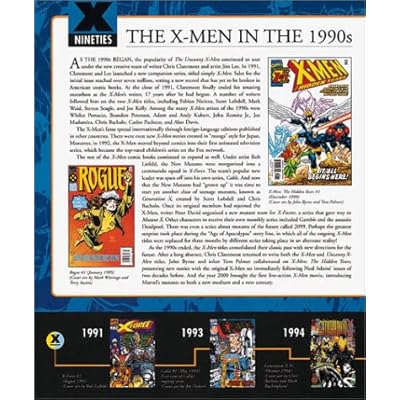Ultimate X-Men
Category: Books,Children's Books,Humor
Ultimate X-Men Details
Amazon.com Review Gorgeous, oversize, and well designed, Ultimate X-Men is also perfectly titled. It's a comprehensive overview of four decades of Marvel Comics's monstrously popular mutant superheroes--from their debut, in Stan Lee and Jack Kirby's X-Men #1 (1963), to the terrific X-Men movie (2000). Ultimate X-Men includes the many major mutants who have appeared in The Uncanny X-Men and its spinoffs (Alpha Flight, New Generation, Wolverine, X-Factor, and numerous other series and miniseries). Two-page spreads detail the most important characters' origins, powers, costumes, and relationships. In addition, every superhero and supervillain appearing in the movie receives a sidebar, with stills, that describes the onscreen incarnation. Also receiving detailed coverage are nonmutants important to the X-Men, including Ka-Zar, Longshot, and Dr. Moira MacTaggert; major alien groups and races, like the Starjammers and the Shi'ar; and important locations and technology, such as the Danger Room, Dr. Xavier's estate, and the Blackbird jets. The book also covers the best Uncanny X-Men story lines, the Dark Phoenix Saga, and Days of Future Past. A Summers family tree lays out clearly a tangle of relationships (between clonal and alternate-timeline versions of Cyclops/Scott Summers and Marvel Girl/Phoenix/Jean Grey) that could drive even an experienced genealogist crazy. Ultimate X-Men opens with an entertaining foreword by X-Men creator-editor Stan Lee and concludes with a two-page overview of the X-Men animated series (1992-1997); a four-page "Making the X-Men Movie" section with many great shots; and an insightful afterword by the series' best writer, Chris Claremont. Ultimate X-Men is a book every X-Men fan will want. It's practically a necessity for the newcomer drawn to the comics by the movie, because Marvel's mutants multiplied like superpowered rabbits in the 1990s. Art-oriented fans, however, may be disappointed by Ultimate X-Men. While it contains a hefty amount of art, the original artwork (the preliminary character sketches, a lovely Dave Cockrum sketch of Nightcrawler and Ororo, etc.) is outnumbered by panel and cover reproductions. And if you're less than enamored with the nature of endless comic-book series, Ultimate X-Men will prove that the more things change, the more they stay the same. --Cynthia Ward Read more Review This book is purposely for fun and it accomplishes its purpose with aplomb. -- VOYA Read more About the Author Peter Sanderson is a popular culture historian specializing in the American comic book. He is the author of Marvel Universe (Harry N. Abrams,1996) and has worked as an assistant editor and staff archivist for Marvel. He was also a contributor to Who's Who in the DC Universe, The Official Handbook of the Marvel Universe, and various magazines about comics. Sanderson earned a bachelor's and two master's degrees in English literature at Columbia University and lives in New York City. Read more

Reviews
This book attempts to be informative, but contains too much information that is too diffuse to be of much use to either new or older fans. There are out-and-out mistakes (for example, Magneto is Jewish (as has been demonstrated in the comics as well as the movie) not a gypsy; i.e. the alias "Erik Lehnsherr" was the name of his false gypsy identity). There are serious omissions, such as the story of Illyana Rasputin or Magik -- reduced to a few sentences that hardly describe the history of this character. Also, the book tends to present bits and pieces of information about one character in the biography or notes about another; for example, the section on Charles Xavier doesn't mention his father, or step-brother Juggernaut, but if one reads the biography of Juggernaut, one finds some of the missing pieces from the Charles Xavier biography. If a reader is using this book as a reference, it is a clumsy and imprecise reference. On the other hand, there are flashy pictures and dynamic layouts to offset the confusing editorial organization and inaccuracies. Future X-Men books should strive for a more simple, straightforward approach that accurately presents each character's most basic history, as well as give readers the spectacular art and schematics and colorful trivia.





